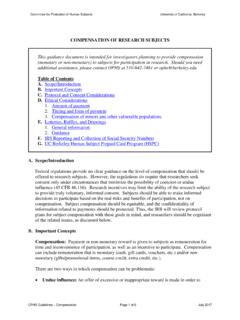Transcription of Internet-Based Research - University of California, Berkeley
1 Committee for Protection of Human Subjects University of California, Berkeley CPHS Guidelines Internet-Based Research Page 1 of 8 September 2020 Internet-Based Research This guidance document is intended for researchers conducting recruitment, informed consent, and/or data collection procedures over the internet . Should you need additional assistance, please contact OPHS at 510-642-7461 or Table of Contents: A. Introduction B. Specific Guidance 1. Recruitment 2. Informed Consent 3. Data Collection 4. Data Security C. Glossary of Terms A. Introduction Recent studies have shown that Internet-Based Research is becoming more and more commonplace. Popular because it is a quick way to gain access to a large number of respondents without expending too many resources, Internet-Based Research is, increasingly, the Research method of choice for surveys.
2 Observations, interventions, and analysis of existing data are also commonly used methods of Internet-Based Research . While this may be good news for investigators, Internet-Based Research brings up difficult issues concerning human subject protections in the application of federal regulations 45 CFR 46 and the ethical principles of the Belmont Report. Topics such as privacy, confidentiality, recruitment, and informed consent become complicated when Research is conducted online. This guidance intends to shed light on a variety of issues surrounding Internet-Based Research and to help investigators design studies that are in line with 45 CFR 46. B. Specific Guidance 1. Recruitment: a. Internet-Based procedures for advertising and recruiting potential participants must follow the Committee for the Protection of Human Subjects (CPHS) guidelines for recruitment that apply to any traditional media, such as flyers and newspaper ads.
3 Examples of Internet-Based recruitment methods include emails, online advertising, and chatroom postings. For non-exempt Research , these texts must be submitted for review and approval before use in the field. b. The proper identification and qualification of subjects is a challenge in Internet-Based Research . Without face-to-face or voice-to-voice interaction, it is difficult for investigators to be sure that participants are not misrepresenting themselves. In certain situations, investigators should discuss measures taken to authenticate subjects. These situations may include studies for which authentication of subjects is Committee for Protection of Human Subjects University of California, Berkeley CPHS Guidelines Internet-Based Research Page 2 of 8 September 2020 important to the validity of the data or that consist of particularly sensitive topics.
4 Examples of such measures include: i. Providing each study participant (in person or by Postal Service mail ) with a Personal Identification Number (PIN) to be used for authentication in subsequent computer- and Internet-Based data collection. In this example, the PIN used must not be one that could be used by others to identify the individual ( social security number, phone number, birth date, etc.). ii. Minors may be screened out by checking for internet monitoring software such as SafeSurf and RSACi rating or using Adult Check systems. This can be necessary if the study presents more than minimal risk to subjects or asks particularly sensitive questions. Or investigators might want to increase the validity of their study by screening out minors if their Research is focused on adult subjects.
5 On the other hand, in most studies involving no greater than minimal risk, it is sufficient for the informed consent document to simply ask participants to confirm that they are the appropriate age of majority. 2. Informed Consent: a. Investigators conducting non-exempt Research must follow the CPHS Informed Consent Guidelines and include required elements of informed consent when generating consent documents. When online surveys are employed, the CPHS consent template for online surveys may be adapted. Investigators conducting Research that qualifies for exempt review should refer to the CPHS guidelines on exempt Research for information regarding informed consent. b. In general, investigators conducting Internet-Based Research with minors must obtain both child assent and parent permission.
6 Researchers may request a waiver of parent permission provided the study fits the appropriate criteria. c. CPHS generally accepts the use of "I agree" or "I do not agree" buttons (or other electronic methods for indicating affirmative consent) on online pages in lieu of signatures. For surveys sent to and returned by participants through email, investigators should include a consent document and inform participants that submitting the completed survey indicates their consent. This would constitute unsigned consent. In order to utilize this consent procedure, the investigator must request a waiver of documented consent. See CPHS Informed Consent Guidelines for further information. d. If the CPHS determines that documented consent is required, the consent form may be mailed or emailed to the participant who can then print and sign the form and return it to investigators via email, postal mail , or fax.
7 Alternatively, a verifiable electronic signature may be obtained. See CPHS FAQ on electronic signatures for more information. e. The process of requesting consent should not disrupt normal group activity. Researchers need to be particularly sensitive of this when entering online communities and chatrooms as the process of requesting consent is often perceived as Committee for Protection of Human Subjects University of California, Berkeley CPHS Guidelines Internet-Based Research Page 3 of 8 September 2020 disruptive. If seeking informed consent will harm the validity of a study or make the Research impracticable, it may be possible to obtain a waiver of consent provided the study meets the appropriate criteria. When requesting a waiver of informed consent, issues regarding deception or incomplete disclosure may need to be addressed in the researcher s eProtocol application.
8 Please see the CPHS Guidelines on Deception and Incomplete Disclosure for further instruction. f. Personas, or avatars, are social identities that internet users establish in online communities and websites. These personas allow individuals to reveal varying levels of personal information and also allow them to navigate the virtual world as a particular character or alter-ego. Names of internet personas (characters or avatars) or real names may be used in reports and publications only with consent from the participating individual (see Data Security below for more information). In these situations, specific language concerning the release of identifiable information must be included in the informed consent document and specific consent must be sought from subjects for this release.
9 If Research participants give consent to be identified, data must still be secured properly to avoid any misuse by a third party. g. Collecting data over the internet can increase potential risks to confidentiality because of the frequent involvement of third party sites and the risk of third party interception when transmitting data across a network. For example, when using a third party website to administer surveys, the website might store collected data on backups or server logs beyond the timeframe of the Research project. In addition, third party sites may have their own security measures that do not match those of the investigators (see Additional Considerations below for more information). Participants should be informed of these potential risks in the informed consent document.
10 For example: i. Although every reasonable effort has been taken, confidentiality during actual internet communication procedures cannot be guaranteed. ii. Your confidentiality will be kept to the degree permitted by the technology being used. No guarantees can be made regarding the interception of data sent via the internet by any third parties (Pennsylvania State University ). iii. Data may exist on backups or server logs beyond the timeframe of this Research project. In addition, CPHS recommends that the informed consent document instruct subjects to close their browser window after participation and suggest that they clear their cache to protect their confidentiality, especially if they use a shared computer. 3.







